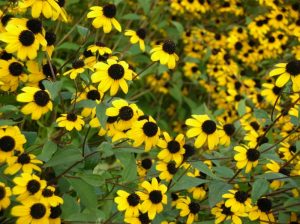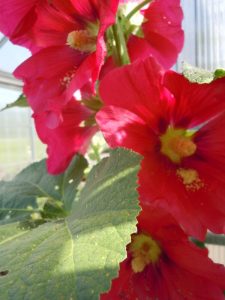
Clematis virginiana
When you bought your house did you think about asking if there had been walnut trees on the property? No, me either. Whew, there aren’t any here but we’re surrounded by neighbors growing them and the squirrels see our property as a good place to plant them. Every year we dig up at least 25 baby walnut trees, and some not so baby ones that we missed the prior year(s).
This may be the key to why not much grows there. Walnuts and all parts of their trees including nuts, roots and wood chips contain the chemical juglone. It’s a killer. To horticulturists, botanists and landscapers it’s called allelopathic. That means it’s a killer, mostly of other plants. Think of it like a walnut would – it’s easier to thrive if you don’t have crowding or competition from other plants. Walnuts do not have a monopoly on allelopathy. The dreaded Garlic mustard (at least it will keep other weeds away), Shagbark hickory, Pecan trees, Sumac, and Goldenrod all contain chemicals that reduce their competition, but nothing’s as strong as the juglone in Black walnut trees.
How long and how far out? I’m told juglone lasts in the soil for some 20 years after the tree’s cut down. Distance is at least as far as the dripline – as far as the roots have grown.
I don’t want to scare you. Go ahead and keep eating walnuts – yum, cookies, cakes, salads etc. But don’t feed them to your horses and don’t play fetch with them with your dogs. Juglone does have some redeeming uses. Juglone is not toxic to humans. It’s a dye for hair and fabric – the nuts stain everything. Because it’s a killer it’s being tested for killing ovarian cancer.
I saved the best for last – quite a number of plants say “devil may care.” Juglone doesn’t get ‘em. Here they are: (If you know of others please let us know)

Rudbeckia triloba
Adiantum pedatum Maidenhair fern
Ajuga – all – Blue bugle
Alcea rosea Hollyhock
Anemone – all
Aristolochia durior Dutchmans pipe
Asarum canadense Wild ginger
Asclepias tuberosa Butterfly weed
Aster – all (and those formerly called Aster that taxonomists gave long names)
Astilbe – all
Athyrium filix-femina Lady fern
Betula nigra River birch
Bouteloua gracilis Blue gramma
Campanula – all
Carex grayi Gray’s sedge
Cercis canadensis Redbud
Chasmanthium latifolium Northern sea oats
Clematis – all
Cornus alternifolia Pagoda dogwood
Dicentra – all- Bleeding heart
Echinacea purpurea Purple coneflower
Eryngium yuccifolium Rattlesnake master
Eupatorium – all Joe pye weed, Blue mist etc.
Galium odoratum Sweet woodruff
Gentian andrewsi Bottle gentian
Geranium (perennials only) – all
Hemerocallis – all- Daylily
Heuchera – all – Coralbells
Hibiscus syriacus Rose of sharon
Hosta – all
Iris sibirica Siberian iris
Kirengeshoma palmata Yellow waxbells
Liriodendron tulipfera Tulip tree
Lobelia –all- Cardinal flower
Lonicera – all – Honeysuckle
Magnolia – all
Monarda –all – Beebalm
Oenothera –all – Sundrops/Primrose

Alcea rosea
Onoclea sensibilis Sensitive fern
Osmunda cinnamomea Cinnamon fern
Phlox – all
Physotegia virginiana Obedient plant
Podophyllum peltatum Mayapple
Polemonium reptans Jacobs ladder
Polygonatum – all – Solomon seal
Polystichum acrostichoides Christmas fern
Primula – all – Primrose
Rubus odoratus Flowering raspberry
Rudbeckia – all – Black/Brown eyed susan
Ribes aureum Clove currant
Salix – all – Willow
Schizachyrium scoparium Little bluestem
Sedum – all
Solidago– all – Goldenrod
Sporobolis heterolepsis Prairie dropseed
Stachys byzantia Lambs ear
Tradescantia virginiana Spiderwort
Trillium – all
Uvularia grandifolia Merrybells
Vernonia – all – Ironweed
Veronica – all –Speedwell
Yucca – all – (nothing can kill these)
